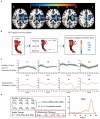A normative modeling approach to quantify white matter changes and predict functional outcomes in stroke patients
- PMID: 38379757
- PMCID: PMC10877717
- DOI: 10.3389/fnins.2024.1334508
A normative modeling approach to quantify white matter changes and predict functional outcomes in stroke patients
Abstract
Objectives: The diverse nature of stroke necessitates individualized assessment, presenting challenges to case-control neuroimaging studies. The normative model, measuring deviations from a normal distribution, provides a solution. We aim to evaluate stroke-induced white matter microstructural abnormalities at group and individual levels and identify potential prognostic biomarkers.
Methods: Forty-six basal ganglia stroke patients and 46 healthy controls were recruited. Diffusion-weighted imaging and clinical assessment were performed within 7 days after stroke. We used automated fiber quantification to characterize intergroup alterations of segmental diffusion properties along 20 fiber tracts. Then each patient was compared to normative reference (46 healthy participants) by Mahalanobis distance tractometry for 7 significant fiber tracts. Mahalanobis distance-based deviation loads (MaDDLs) and fused MaDDLmulti were extracted to quantify individual deviations. We also conducted correlation and logistic regression analyses to explore relationships between MaDDL metrics and functional outcomes.
Results: Disrupted microstructural integrity was observed across the left corticospinal tract, bilateral inferior fronto-occipital fasciculus, left inferior longitudinal fasciculus, bilateral thalamic radiation, and right uncinate fasciculus. The correlation coefficients between MaDDL metrics and initial functional impairment ranged from 0.364 to 0.618 (p < 0.05), with the highest being MaDDLmulti. Furthermore, MaDDLmulti demonstrated a significant enhancement in predictive efficacy compared to MaDDL (integrated discrimination improvement [IDI] = 9.62%, p = 0.005) and FA (IDI = 34.04%, p < 0.001) of the left corticospinal tract.
Conclusion: MaDDLmulti allows for assessing behavioral disorders and predicting prognosis, offering significant implications for personalized clinical decision-making and stroke recovery. Importantly, our method demonstrates prospects for widespread application in heterogeneous neurological diseases.
Keywords: Mahalanobis distance; normative modeling; prognosis; stroke; white matter microstructure.
Copyright © 2024 Su, Yan, Zhu, Liu, Zhang, Peng, Zhang, Li and Zhu.
Conflict of interest statement
The authors declare that the research was conducted in the absence of any commercial or financial relationships that could be construed as a potential conflict of interest.
Figures




Similar articles
-
Brain white matter changes in asymptomatic carriers of Leber's hereditary optic neuropathy.J Neurol. 2019 Jun;266(6):1474-1480. doi: 10.1007/s00415-019-09284-2. Epub 2019 Mar 25. J Neurol. 2019. PMID: 30911824
-
Diffusion Tensor Imaging With Tract-Based Spatial Statistics Reveals White Matter Abnormalities in Patients With Vascular Cognitive Impairment.Front Neuroanat. 2018 Jun 26;12:53. doi: 10.3389/fnana.2018.00053. eCollection 2018. Front Neuroanat. 2018. PMID: 29997482 Free PMC article.
-
Diffusion-tensor imaging of major white matter tracts and their role in language processing in aphasia.Cortex. 2016 Dec;85:165-181. doi: 10.1016/j.cortex.2016.04.019. Epub 2016 May 4. Cortex. 2016. PMID: 27289586
-
Alterations in White Matter Fiber Tracts Characterized by Automated Fiber-Tract Quantification and Their Correlations With Cognitive Impairment in Neuromyelitis Optica Spectrum Disorder Patients.Front Neurosci. 2022 Jul 1;16:904309. doi: 10.3389/fnins.2022.904309. eCollection 2022. Front Neurosci. 2022. PMID: 35844220 Free PMC article.
-
Dissociations in white matter tracts and neuropsychological findings in a 17 years old patient with Subacute sclerosing panencephalitis.Brain Cogn. 2023 Feb;165:105941. doi: 10.1016/j.bandc.2022.105941. Epub 2022 Dec 24. Brain Cogn. 2023. PMID: 36571871 Review.
Cited by
-
Functional connectivity and white matter microstructural alterations in patients with left basal ganglia acute ischemic stroke.Brain Imaging Behav. 2025 Apr;19(2):421-432. doi: 10.1007/s11682-025-00982-2. Epub 2025 Feb 18. Brain Imaging Behav. 2025. PMID: 39964657
References
-
- Bonkhoff A. K., Hong S., Bretzner M., Schirmer M. D., Regenhardt R. W., Arsava E. M., et al. . (2022). Association of Stroke Lesion Pattern and White Matter Hyperintensity Burden with Stroke Severity and outcome. Neurology 99, e1364–e1379. doi: 10.1212/WNL.0000000000200926, PMID: - DOI - PMC - PubMed
-
- Chen H. F., Huang L. L., Li H. Y., Qian Y., Yang D., Qing Z., et al. . (2020). Microstructural disruption of the right inferior fronto-occipital and inferior longitudinal fasciculus contributes to WMH-related cognitive impairment. CNS Neurosci. Ther. 26, 576–588. doi: 10.1111/cns.13283, PMID: - DOI - PMC - PubMed
LinkOut - more resources
Full Text Sources

